By: Gabriel Frank-McPheter
Acknowledgements: Thank you to Deland Chan and Remy De La Peza for supervising this project, and to Eric Wu for assisting in data collection and producing the graphs and charts in this memo. A special thank you to all of the members of the CBDC for their feedback. This work builds on research on alternative ownership models by Stanford students in a community-engaged learning course; thank you to Sara Hernandez, Anastazja Krostenko, and Adriana Torres Ceja for this work.
Background
The California Community-Based Development Collective (CBDC) consists of 12 community development organizations historically led by and serving people of color across the state.[1] The collective includes both established, long-standing community developers, and more emerging affordable housing and community development organizations. It was first formed in 2020 to facilitate peer-learning and engage in collective advocacy.
CBDC members are dedicated to supporting place-based community development, a model where community members in historically marginalized neighborhoods play a central role in creating their own vibrant, resilient and thriving communities. This ground-up approach emphasizes culturally-driven prosperity over the traditional market-driven model. Place-based community developers invest in their neighborhoods to bring opportunities to low-income people and people of color where they live, allowing local relationships, assets, and needs to guide investment, rather than investment dictating the location and nature of development. In doing so, CDCs often collaborate with local service providers, foster community organizing, and provide holistic programming for its residents. As California grapples with a dire affordable housing crisis, gentrification of historic ethnic neighborhoods, and persistent and new patterns of racial segregation, place-based community development offers a vision of an equitable future where all communities benefit from safe and affordable housing, economic opportunities, and socially cohesive neighborhoods.
CBDC member organizations alone have already made enormous impacts across the state, housing 19,523 residents and serving 138,005 clients annually. Still, California has room to implement stronger policies and offer more resources to support and expand the place-based community development model. This brief, and CBDC’s advocacy, aims to educate policymakers, funders, other developers, and the general housing and community development sectors about the success of place-based community development, and the importance of providing established and emerging CDCs the resources they need to continue and grow their impact across the state.
Figure 1: CBDC Member Information (Author: Eric Wu)
| Organization Name | Year Founded | County |
| The Unity Council | 1964 | Alameda |
| MAAC Housing Corporation | 1965 | San Diego |
| Young Community Developers | 1972 | San Francisco |
| Mission Economic Development Agency | 1973 | San Francisco |
| East Bay Asian Local Development Corporation | 1975 | Alameda |
| Chinatown Community Development Center | 1977 | San Francisco |
| Little Tokyo Service Center | 1980 | Los Angeles |
| Tenderloin Neighborhood Development Corporation | 1981 | San Francisco |
| Canal Alliance | 1984 | Marin |
| East Palo Alto Community Alliance and Neighborhood Development Organization | 1991 | San Mateo |
| Coalition for Responsible Community Development | 2005 | Los Angeles |
| SV@Home (*not itself a place-based CDC but close partner) | 2016 | Santa Clara |
Figure 2: Map of CBDC Member Headquarters (Author: Gabriel Frank-McPheter)

The Place-Based Community Development Model
Community Development Corporations (CDCs) emerged nationally in the 1950s-60s alongside civil rights movements when grassroots campaigns led by people of color organized for community control and empowerment over economic conditions and development.[2] Emerging CDCs in the 1960s-70s received funding from antipoverty programs and later the Community Development Block Grant. As the model gained traction, financial intermediaries called Community Development Financial Institutions (CDFIs) formed in the 1980s to facilitate social investing and philanthropic lending to CDCs. Around the same time, the creation of the Low-Income Housing Tax Credit (LIHTC) and other policy changes shifted funding towards non-profit affordable housing developers, including CDCs.[3]
Figure 3: Nationwide CDC Activities (Source: Urban Institute)[4]
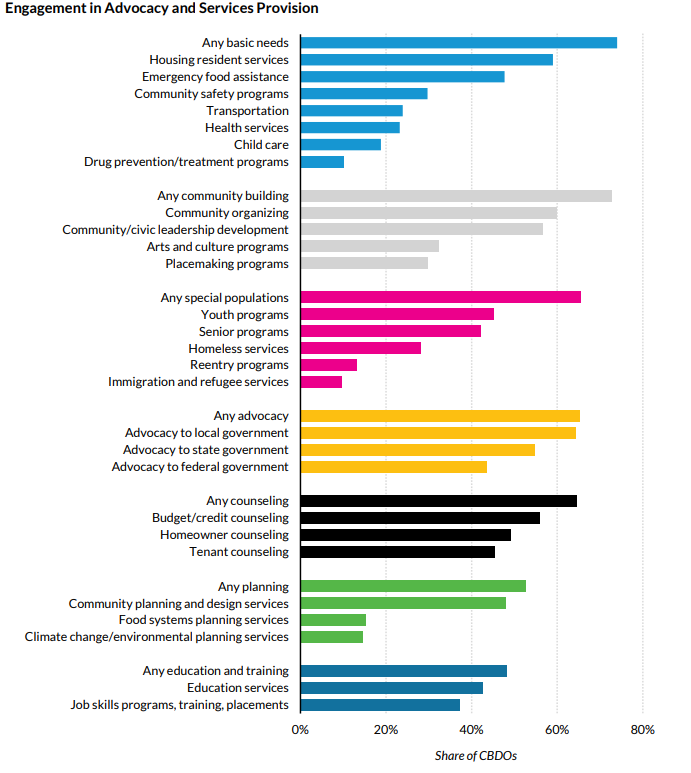
Place-based CDCs focus on specific geographic areas, tailoring their efforts to the unique needs and histories of those neighborhoods. Rather than targeting a broad demographic or letting investment dictate where they develop, place-based community developers let local relationships and needs guide where and how to invest and operate in particular neighborhoods. This approach strengthens local social cohesion, improves quality of life, and brings resources to historically marginalized neighborhoods on residents’ own terms.
While there is no singular technical definition of a place-based CDC, most ensure some level of community representation or input in executive boards, staff, projects, and programs. This includes 9 in 10 CDCs who recruit board members directly from the community, and 65% of CDCs who engage community members in advisory roles on projects and programs.[6]
Measuring CBDC Members’ Impacts in California
CBDC members have produced a total of 17,305 housing and commercial units in California, providing homes to 19,523 residents and annually serving over 138,000 clients (Figure 4). The programs CBDC member organizations provide include community organizing, food services, and workforce development, to name a few (Figure 6). These enormous impacts provide homes for people to live, support the local economy, and build and maintain social relationships and cohesion in historically marginalized neighborhoods.
Moreover, these are just the impacts of these 12 CBDC member organizations. California includes other place-based community developers whose efforts only add to this overall impact. The portfolios and programs of CBDC members alone, though, show just how significant place-based community development is in addressing the affordable housing shortage, serving residents in lower-resourced neighborhoods, and providing programs that support and foster community.
Figure 4: Combined Impacts of CBDC Members (Author: Eric Wu)
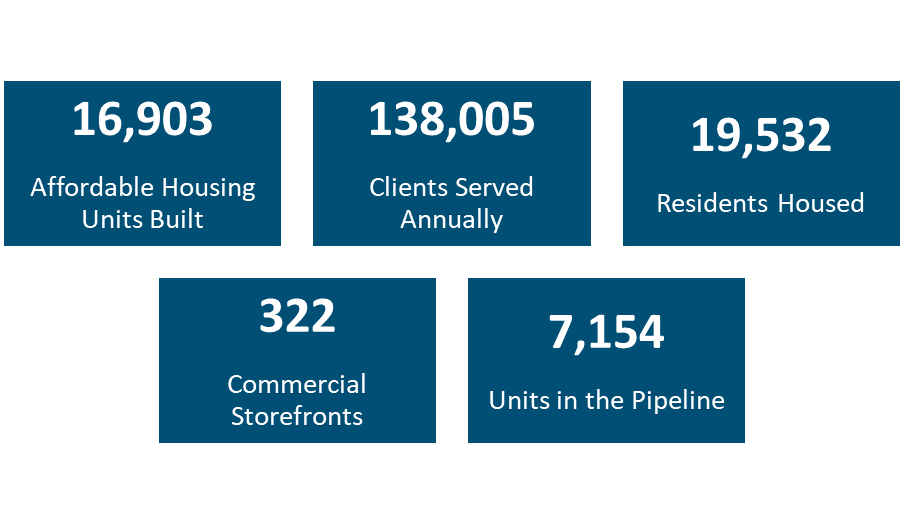
Figure 6: Types of Programs and Services Offered by CBDC Members (Author: Eric Wu)
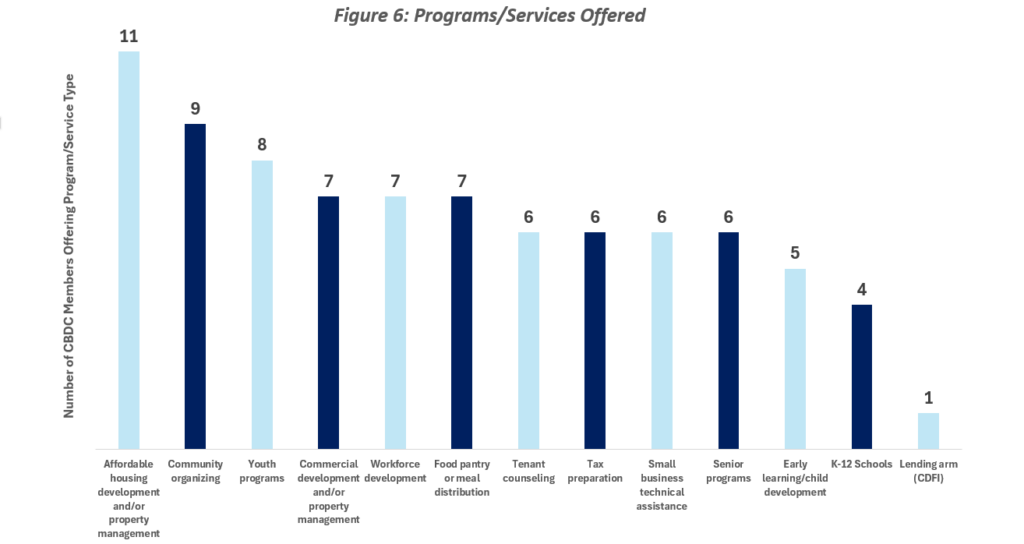
Figure 7: Map of CBDC Member Properties (Author: Gabriel Frank-McPheter)
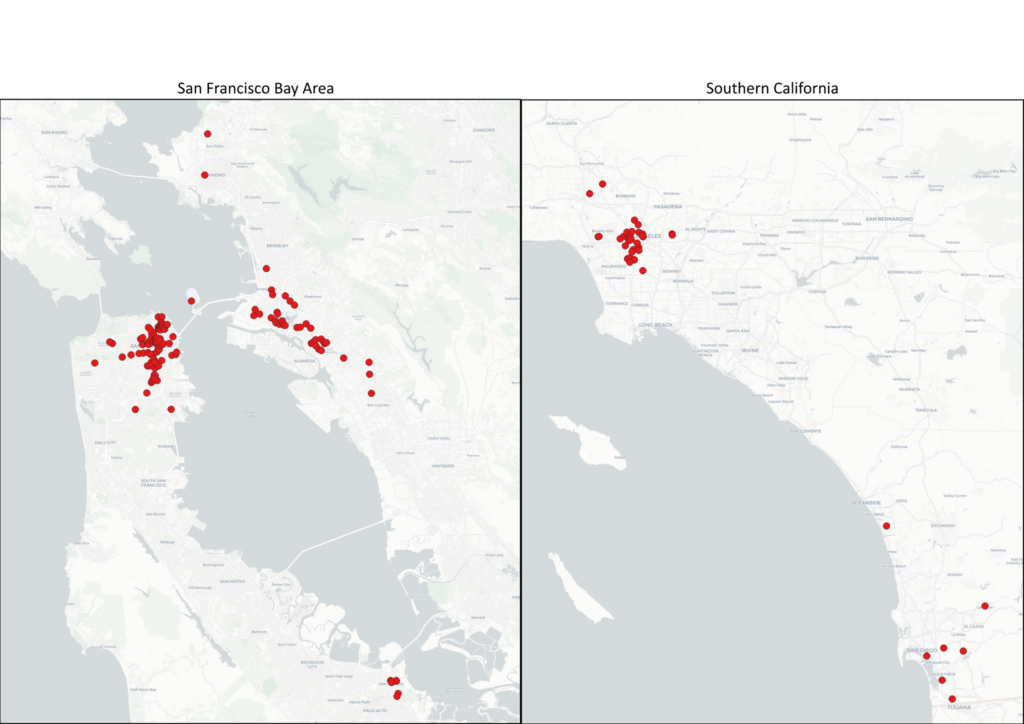
Challenges
Preservation
Because the CDC model emerged in the 1960s-80s, many CDC affordable housing developments are now in need of retrofitting and capital improvements, while also reaching the end of their affordability deed-restrictions. The same is true for many other LIHTC developments and naturally-occurring affordable housing units in the communities in which CDCs operate. CBDC member organizations need access to more funding opportunities to preserve, rehabilitate and retrofit their current portfolios, and acquire and preserve affordable housing in their communities.
Rising Insurance Costs
Premiums for property, liability, and builders’ risk insurance have skyrocketed, in some cases as high as 400-600% per year.[7] This significantly increases the cost for CDCs to develop and preserve affordable housing and commercial properties, and in some cases, makes development untenable.
Gentrification and Displacement
Figure 8: CBDC Members’ Annual Budgets (Author: Eric Wu)
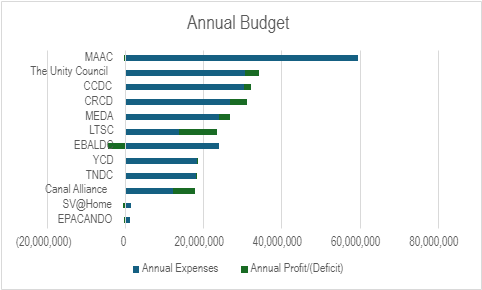
Many communities of color across California are at risk of displacement as gentrification pressures rise. Place-based community developers are at the forefront of sustaining these BIPOC and low-income neighborhoods. However, CDCs may lose important funding opportunities due to recent changes in state policy that give greater scores to higher-resourced neighborhoods when awarding limited affordable housing subsidies. While intended to provide low-income people more opportunities to move to higher-resourced areas, this change assumes people want to leave their communities and also makes CDCs operating in the historically disinvested in neighborhoods still very much in need of affordable housing the least likely to receive public investment for more affordable housing.[8]
Organizational Model Sustainability
Insufficient public funding to address challenges like rising insurance costs, rental arrear payments, and others have fiscally impacted CBDC member organizations; as Figure 8 shows, expenses outpace revenue for most members, and some are facing debt.
Next Steps and Opportunities
CBDC Current Advocacy
- Tax credit allocation: CBDC has engaged in significant advocacy with the California Tax Credit Allocation Commission (CTCAC) for a fairer affordable housing tax credit project scoring system that doesn’t further disadvantage under-resourced neighborhoods. CBDC continues to monitor funding regulations and advocate on behalf of equitable affordable housing investment in neighborhoods most in need.
- Strategies for preservation: CBDC is tracking federal climate funding, such as the Inflation Reduction Act (IRA) and the Greenhouse Gas Reduction Fund (GGRF), and working with member organizations to assess their portfolios and prepare to access capital for preservation through these sources. CBDC is also sharing strategies and learnings on the feasibility of small-site acquisition and rehabilitation in their respective housing markets.
- Addressing insurance costs: CBDC member organizations in Los Angeles are working in coordination with the Southern California Association of Nonprofit Housing to address rising insurance costs, including talking to the L.A. Times to uplift the impact of this issue on our communities. Members are also tracking federal efforts through HUD and state efforts through the Senate Insurance Working Group to address insurance costs.
Other Opportunities to Support Place-Based Community Development
- Prop 5: If passed, this historic ballot measure will amend California’s constitution to lower the voting threshold to pass local housing and infrastructure bonds from two-thirds to 55%. This will make it easier for local and regional governments to pass bond measures to fund affordable housing development, including by CDCs. Given the history of place-based developers in community advocacy and organizing, lowering the threshold with Prop 5 would also make it easier for place-based developers to win organized campaigns for housing bonds.
- L.A. County $1.2B Ballot Measure: LA County’s Measure A proposes to replace the 25 cent Measure H sales tax with a 50 cent sales tax, generating $1.2B in revenue each year. 24% of funds will go to housing production, and 10% to flexible funds for innovative solutions.[9] Los Angeles-based CDCs can leverage these dollars to fund new projects, and demonstrate the innovative success of their model.
- Emerging community-based developers: CBDC connects CDCs of all experience levels, enabling established members to support emerging ones. Many members also assist local CBOs who are increasingly more interested in this model and becoming a CDC. In Santa Clara County, SV@Home’s Community Roots Collective unites and educates local CBOs beginning their first projects in place-based development. In Los Angeles, Little Tokyo Service Center’s Neighborhood-Based Housing Collaborative has provided technical assistance on affordable housing development to over 30 CBOs, including partnering with the Boyle Heights community land trust Fideicomiso Comunitario Tierra Libre in purchasing its first property.
Appendix – Project and Program Highlights of CBDC Members
East Bay Asian Local Development Corporation – Swan’s Market
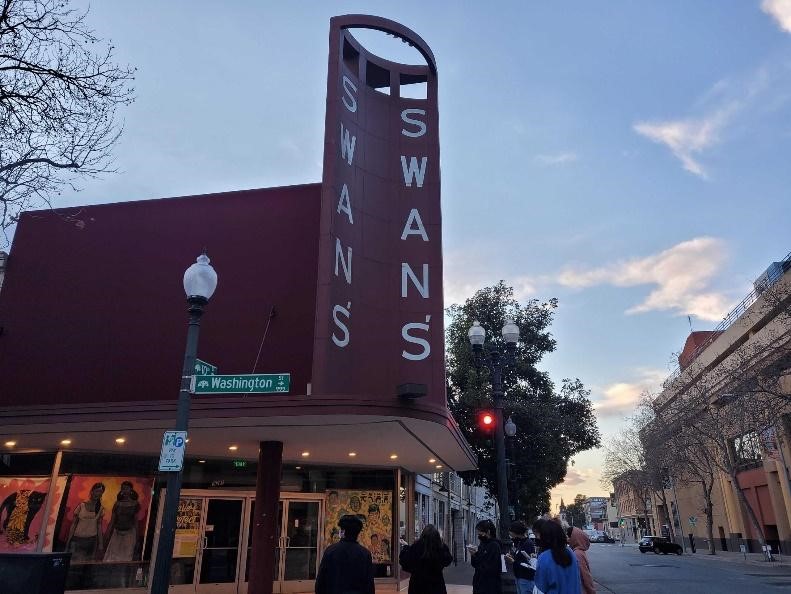
(Source: EBALDC)
In 2000, the East Bay Asian Local Development Corporation (EBALDC) completed its rehabilitation of Oakland’s historic Swan Market. The site hosts diverse local ethnic restaurants, professional offices, 19 affordable housing units, 20 co-housing units, a community garden, and the Museum of Children’s Art. Place-based projects like Swan’s Market provide far more than that of traditional large-scale non-profit affordable housing development: they offer opportunities for local small businesses, center diverse cuisines and cultures, and provide wonderful community spaces and amenities.
Chinatown Community Development Center – Feed and Fuel Chinatown

(Source: CCDC)
During the COVID-19 pandemic, ethnic small businesses in San Francisco’s Chinatown faced financial hardships and closure, while low-income residents struggled with food insecurity. To address both issues, Chinatown Community Development Center launched the Feed and Fuel Chinatown program. In its initial rollout, the program secured local funding to provide 122,000 meals to Chinatown SRO residents, sourced from 34 Chinatown restaurants.[10] This place-based initiative helped low-income residents, supported local small-business owners, and preserved ethnic restaurants that were essential to the neighborhood’s cultural character.
Silicon Valley at Home – Community Roots Collaborative
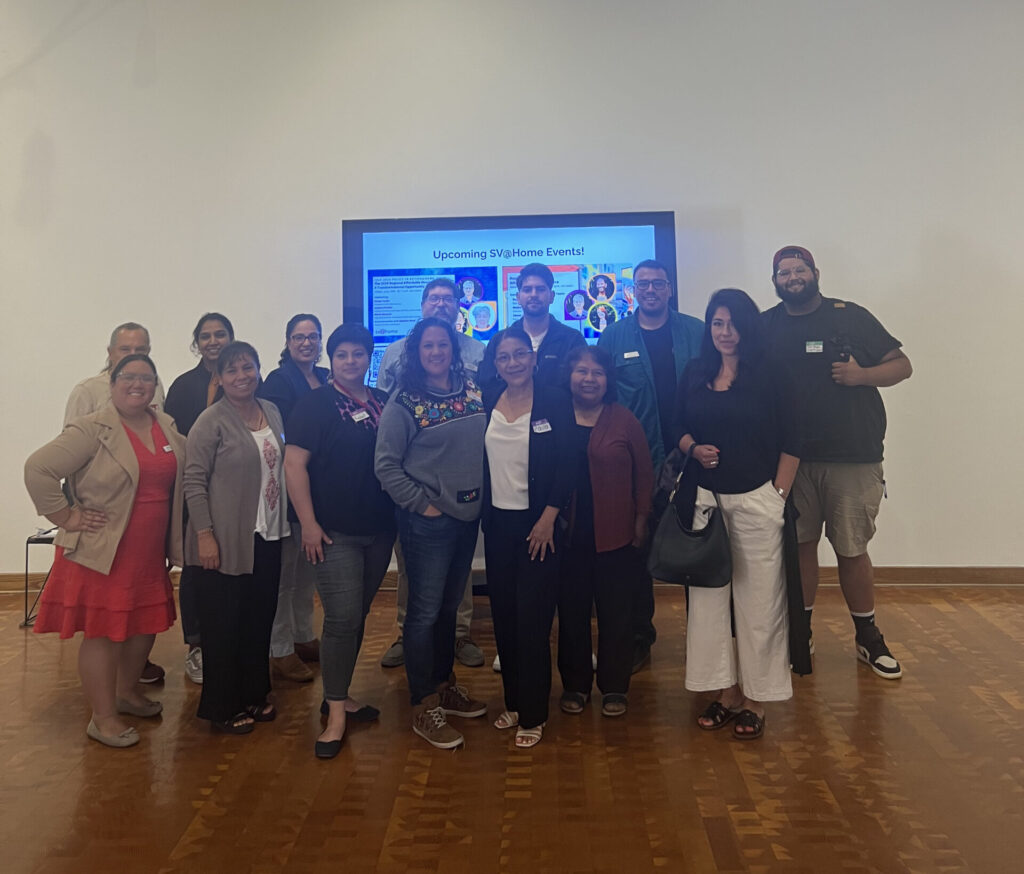
(Source: SV@Home)
While not a developer itself, SV@Home is a non-profit that advances housing justice in Silicon Valley, and a CBDC member. SV@Home hosts the Community Roots Collaborative (CRC) to facilitate the emergence of community developers in Santa Clara County. The collaborative of 14 CBOs meets monthly to discuss progress on members’ community development efforts, receive presentations and information on community development, and learn from other community developers across the Bay Area. Their efforts reflect the reality that as economic inequality and the housing crisis worsens, many CBOs are hungry to enter the field of place-based community development to meet neighborhood needs.
Little Tokyo Service Center –
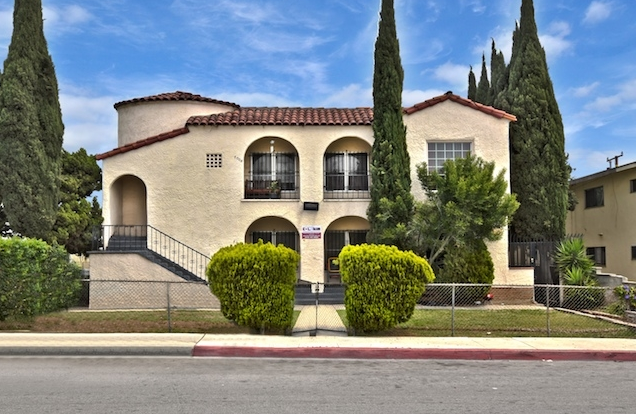
Little Tokyo Service Center (LTSC) in Los Angeles partnered with Fideicomiso Comunitario Tierra Libre (Fideicomiso), the first community land trust in East LA, through the Los Angeles County Community Land Trust Pilot Partnership Program. This program brought emerging CLT’s and established CDCs together to acquire, rehabilitate, and maintain the affordability of small to medium multifamily housing properties in the county with high displacement risk. Through this partnership, LTSC acquired an 11-unit property in East LA with the intent to transfer ownership to Fideicomiso once rehabilitation is complete. Fideicomiso will then transition the property to a limited equity housing cooperative, with tenants of the property owning shares. This partnership is crucial for emerging CLT’s who often do not have
the budgets and/or organizational infrastructure to take on multi-million dollar capital projects and structure the layers of capital that can sometimes be required for real estate deals. By partnering with LTSC, Fideicomiso not only benefited from the added capacity and learning opportunity but they also had a partner that shared their values for people over profit and genuinely cared about their vision of tenant ownership. (Photo Source: Enterprise Community Partners)
[1] The members of CBDC are not the only place-based community development corporations in California.
[2] See Josh Ishimatsu, “Elsie Richardson: Unsung Founder of Community Development,” Silicon Valley at Home, Heart and Home, April 11, 2024, https://siliconvalleyathome.org/heart-and-home-column-by-josh-ishimatsu-elsie-richardson-unsung-founder-of-community-development/; Fighting for Justice: New York Voices of the Civil Rights Movement, Bedford Stuyvesant Restoration Corporation (Vimeo, 2010), https://vimeo.com/8897600.
[3] Alexander von Hoffman, “The Past, Present, and Future of Community Development in the United States,” Harvard University Joint Center for Housing Studies, December 2012, https://www.jchs.harvard.edu/sites/default/files/w12-6_von_hoffman.pdf
[4] “Engagement in Advocacy and Services Provision,” from Corianne Payton Scally et al., “The State of Community-Based Development Organizations: Results from the Sixth National Census of Community-Based Development Organizations,” Figure Urban Institute, September 2023, https://www.urban.org/sites/default/files/2023-11/The%20State%20of%20Community-Based%20Development%20Organizations.pdf.
[5] Ibid Note 3.
[6] Ibid Note 3.
[7] The Times Editorial Board, “Editorial: California’s next Affordable Housing Crisis Is the Rising Cost of Property Insurance,” Los Angeles Times, June 11, 2024, https://www.latimes.com/opinion/story/2024-06-11/editorial-californias-next-affordable-housing-crisis-is-the-rising-cost-of-property-insurance.
[8] Alison Cingolani, “Fair Housing and the State’s Opportunity Maps,” SV@Home, January 5, 2024, https://siliconvalleyathome.org/fair-housing-and-the-states-opportunity-maps/.
[9] Our Future L.A. County Coalition, “Affordable Housing, Homelessness Solutions & Prevention Now,”
https://file.lacounty.gov/SDSInter/bos/supdocs/186696.pdf
[10] Collyn Chan and Amy Zhou, “How to Save Chinatown: Preserving Affordability and Community Service through Ethnic Retail,” Berkeley Planning Journal 32, no. 1 (August 9, 2022), https://doi.org/10.5070/bp332052798.
